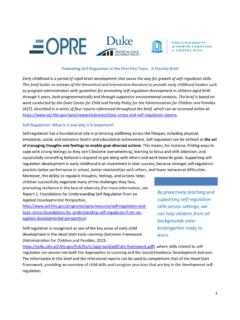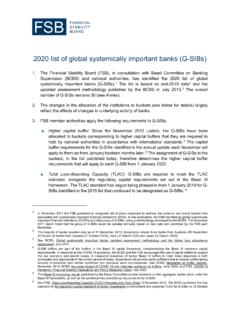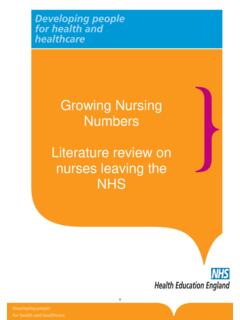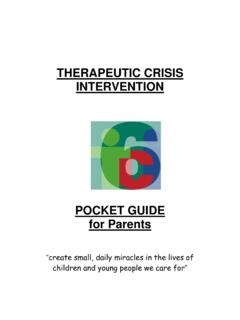Transcription of Co-Regulation From Birth Through Young Adulthood: A ...
1 1 Co-Regulation From Birth Through Young Adulthood: A Practice Brief Adult caregivers such as parents, teachers, coaches, and other mentors play a critical role in shaping and supporting self-regulation development from Birth Through Young adulthood Through an interactive process called Co-Regulation . This brief builds on reviews of the theoretical and intervention literature to provide caregivers and program administrators with guidelines for effective Co-Regulation support at each stage of development. The brief is based on work conducted by the Duke Center for Child and Family Policy for the Administration for Children and Families (ACF), described in a series of four reports referenced throughout the brief, which can be accessed online at Co-Regulation : What is it and why is it important?
2 Self-regulation has become recognized for its foundational role in promoting wellbeing across the lifespan, including educational achievement and physical, emotional, social and economic health. Self-regulation can be defined as the act of managing thoughts and feelings to enable goal-directed actions, and includes a variety of behaviors necessary for success in school, relationships, and the workplace (Murray, Rosanbalm, Christopoulos, & Hamoudi, 2015: Foundations for Understanding Self-Regulation from an Applied Developmental Perspective, ). Although it may sound like something internal to an individual, self-regulation develops Through interaction with caregivers such as parents, teachers, coaches, and other mentors.
3 Further, self-regulation development is dependent on predictable, responsive, and supportive environments. Because caregivers are vital to self-regulation development, teaching adults in caregiving roles to promote self-regulation can be powerful. The supportive process between caring adults and children, youth, or Young adults that fosters self-regulation development is called Co-Regulation . This term began as a description of adult support for infants, but is now used to describe an interactive process of regulatory support that can occur within the context of caring relationships across the lifespan. Co-Regulation will look different at different ages as child capacity for self-regulation grows, but remains a critical resource across development.
4 This brief describes Co-Regulation skills and strategies for caregivers at each stage from Birth Through Young adulthood. 2 What caregiver behaviors contribute to Co-Regulation ? In this brief, the term caregiver is used to describe any adult who provides care and support to a child, youth, or Young adult. This includes but is not limited to parents, guardians, teachers, child care providers, coaches, youth group leaders, and other mentors. Regardless of their role, a caregiver s warmth, responsiveness, and sensitivity support self-regulation development and may buffer the effects of adverse childhood experiences. Effective Co-Regulation by a supportive caregiver will promote self-efficacy and allow children, youth, and Young adults to feel secure enough to practice new skills and learn from mistakes.
5 There are three broad categories of support that caregivers can provide to children, youth, and Young adults that will help them to develop foundational self-regulatory skills and expand these skills to meet increasingly complex regulatory needs as they grow (Murray et al., 2015): Provide a warm, responsive relationship by displaying care and affection; recognizing and responding to cues that signal needs and wants; and providing caring support in times of stress . Caregivers can build strong relationships with children, youth, and Young adults by communicating, Through words and actions, their interest in the Young person s world, respect for the Young person as an individual, and commitment to caring for the Young person no matter what ( , unconditional positive regard).
6 Structure the environment to make self-regulation manageable, providing a buffer against environmental stressors. This means creating an environment that is physically and emotionally safe for children, youth, and Young adults to explore and learn at their level of development without serious risk to their wellbeing. Consistent, predictable routines and expectations likewise promote a sense of security by providing clear goals for behavior regulation, in addition to well-defined logical consequences for negative behaviors. Teach and coach self-regulation skills Through modeling, instruction, opportunities for practice, prompts for skill enactment, and reinforcement of each step towards successful use of skills.
7 Like a coach on a sports team, caregivers should first teach skills, and then provide needed supports, or scaffolding, for self-regulation enactment in the moment. What about caregiver self-regulation? The first thing for caregivers such as parents, teachers, coaches, and other mentors to focus on is their own capacity for self-regulation. To co-regulate successfully, caregivers will need to: 3 Pay attention to their own feelings and reactions during stressful interactions with a child, youth, or Young adult. Pay attention to their own thoughts and beliefs about the behaviors of others. Use strategies to self-calm and respond effectively and compassionately.
8 Caregivers greatly benefit when they take a moment for some deep breaths or self-talk. When a caregiver responds calmly to a child, youth, or Young adult, it helps to keep the Young person s feelings from escalating and also models regulation skills. Self-regulation during a stressful interaction with a child, youth, or Young adult is no easy task, particularly when there are multiple activities and stressors vying for a caregiver s mental and emotional resources. Caregivers may need support, practice, and coaching from friends/family or professionals to build their own coping and calm-down skills, which in turn will aid them in promoting these skills for the children, youth, and Young adults in their care.
9 How much Co-Regulation is needed? Capacity for self-regulation develops over time, from infancy Through Young adulthood (and beyond). Consequently, the amount of Co-Regulation a child, youth, or Young adult needs will vary as they grow. The graph below presents a theoretical model of the balance of a Young person s capacity for self-regulation and need for adult support. This is merely a conceptual depiction of normative growth in self-regulation capacity; the exact ratio will vary by individual and situation. One way of thinking about this ratio is that, for optimal functioning in the moment, children, youth, and Young adults need to have their self-regulation bucket filled.
10 Depending on developmental stage, environmental circumstances, and individual differences, Young people themselves have the capacity to fill their self-regulation bucket to varying levels. To successfully manage their thoughts, feelings, and behaviors, they need caregivers to provide Co-Regulation that fills the remainder of the bucket. As illustrated by the red ovals in the graph below, there are two clear developmental periods where child and youth abilities to self-regulate can increase dramatically due to corresponding changes in brain development. These are early childhood and early adolescence. During these periods, intervention and Co-Regulation support can capitalize on child and youth readiness to build and practice new self-regulation skills.











